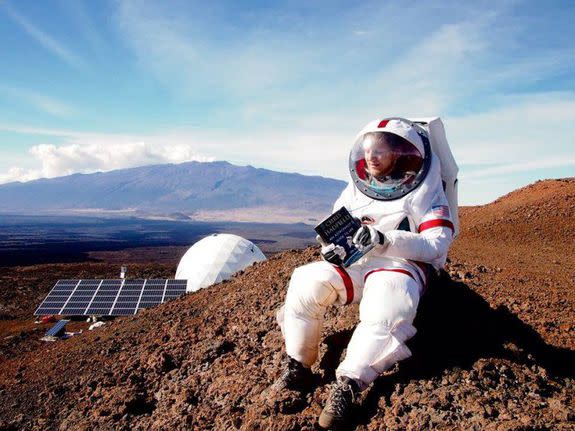6 scientists are living like they're on Mars for the next 8 months

A group of researchers have just begun their eight-month-mission on Mars.
Well, kind of.
On Thursday, six crewmembers entered the geodesic dome that will be their home on Hawaii's Mauna Loa volcano for the next eight months as they live out a simulated mission on the red planet.
SEE ALSO: This is what you look like from Mars
This marks the start of a mission funded by NASA to help the space agency figure out how people might behave during a real long-duration trip to the red planet.
"During the eight-month HI-SEAS Mission V the crew will perform exploration tasks such as geological fieldwork and life systems management," the University of Hawaii said in a statement.
The HI-SEAS missions are designed, at least in part, to help NASA figure out exactly how people will behave under conditions similar to those astronauts may face on Mars.
NASA wants to send people to Mars sometime in the coming decades, and in order to do so, the agency will need to do more than develop technologies for life support and transportation.

Image: HI-SEAS
NASA will also have to contend with the psychological issues that could crop up from a crew that spends years in isolated, cramped quarters for such a mission.
These kinds of problems have been documented in astronauts who have flown to the International Space Station for extended periods of time.
For example, NASA's Scott Kelly — the astronaut who spent a year in space from 2015 to 2016 — admits that he had to contend with a host of physical as well as mental challenges as a result of his trip to orbit.
“During my time in orbit, I lost bone mass, my muscles atrophied, and my blood redistributed itself in my body, which strained my heart," Kelly said in a statement announcing a book deal.
"Every day, I was exposed to ten times the radiation of a person on Earth, which will increase my risk of a fatal cancer for the rest of my life. Not to mention the psychological stress, which is harder to quantify and perhaps as damaging.”
"The isolated and confined conditions of the mission, including 20-minutes of delayed communication and partial self-sufficiency, have been designed to be similar to those of a planetary surface exploration mission," the university said in the statement.
They also won't be allowed outside without protection like a spacesuit.
Basically, they'll live like they're on another planet.
This HI-SEAS crew was chosen specifically as a way to test out models for the composition of future Mars-bound missions, according to the program.
The crew includes engineers Laura Lark, Ansley Barnard, Joshua Ehrlich and Brian Ramos, and PhD candidate in astrobiology Samuel Payler and freelance researcher James Bevington.
HI-SEAS isn't the only Mars simulator out there.
The Mars500 simulation, for example, isolated a crew of people for more than 500 days to see how they behaved and worked together.
